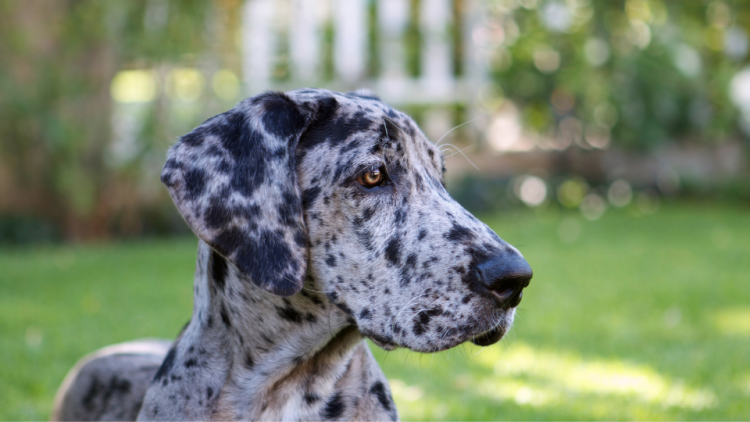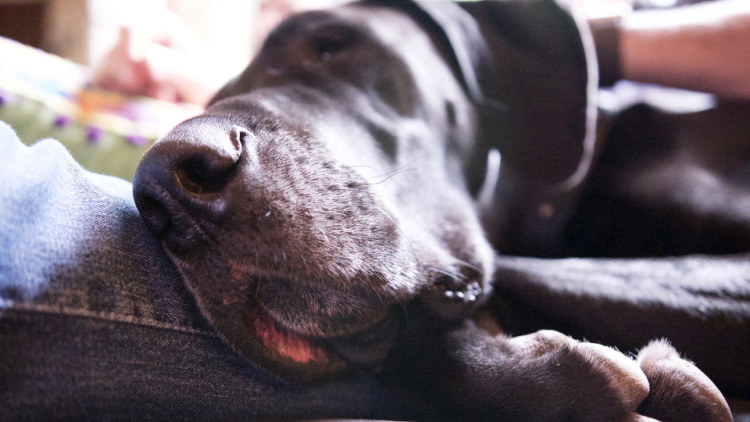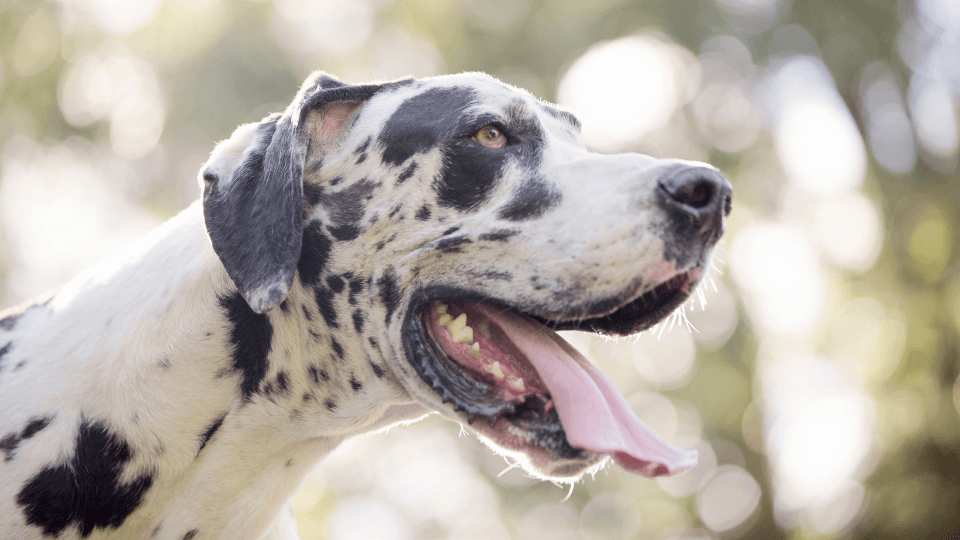Thinking about welcoming a Great Dane into your family? Often called gentle giants, Great Danes are joyful, loyal, and intelligent dogs. Due to the warm temperament, the mighty “Apollo of Dogs,” can be a great companion, but owning a pet of such great size and strength is a serious commitment.
Read on to learn more about Great Danes, including their history, characteristics, care, health issues, and figure out whether this is the right breed for you.
Table of Contents:
- Great Dane Characteristics
- Great Dane History
- Great Dane Care
- Great Dane Health Issues
- Key Takeaways
Pro Tip: Want to be reimbursed for up to 90% of your pet’s vet bills whenever they are sick or injured? Compare Great Dane health insurance plans and make sure that your pup gets the care they need at any stage of their life.
Great Dane Characteristics
Physical appearance
Great Danes, also known as the German Mastiff or Deutsche Dogge, are big and powerful dogs with regal appearance. Female Danes can weigh up to 140 lbs (about 63 kg) and reach 30 inches in height, whereas males weigh up to 170 lbs (77 kg) and are about 32 inches tall.
Their massive head is narrow and flat on top with prominent brows and ears dropping forward. The Great Dane's body is muscular, with straight front legs, long and strong neck, and a thick, medium-length tail.
Great Danes have a short and sleek coat that comes in a variety of colors, including black, fawn, blue, or harlequin (black patches over a white background).
Unfortunately, the lifespan of these dogs is somewhat poor - Great Danes live up to eight years.
Personality
Despite their size, Great Danes are considered to be very gentle. They’re affectionate, moderately playful, and will guard their home. They’re good with kids and generally get along with other pets, especially if socialized with them from a young age. These gentle giants are easy to train, but some individuals can be stubborn learners.

Great Dane History
Great Danes originated in Germany, most likely from the Irish Wolfhound and the English Mastiff. Some believe that they even have an ancient origin as drawings of dogs who look like Great Danes have been found on Egyptian artifacts and in Babylonian temples.
Great Danes were originally developed as boar hunters but as German breeders aimed to refine the breed, they became more known as watchdogs and companions over time.
The breed appeared in the US in the 19th century and was soon recognized by the AKC. Today, the Great Dane is very popular, currently ranking 15th on the AKC’s list of most popular breeds.
Great Dane Care
Training and exercise
Puppy training classes and early socialization will help your Great Dane grow into an adaptable and well-behaved adult. Obedience training is also a must for this large and powerful breed. Great Danes are friendly, sociable, and respond well to consistent training. Considering their extra-large size, consistent training from an early age is crucial to ensure that your Great Dane is well behaved.
Great Dane puppies tend to be very energetic but they should not be allowed to jump in order to keep their growing bones healthy. Jogging and hiking should also be avoided until they’re 18 months old.
Adult Great Danes, on the other hand, might seem a bit sedate but they still require daily exercise. A 15-30 minute walk two to three times per day should be enough to keep your dog healthy and in good shape. Many Great Danes enjoy participating in obedience, agility, tracking events, as well as weight pulls and sports like flyball.
Avoid vigorous exercise around mealtimes to help reduce the chances of canine bloat which is quite common in Great Danes.
Grooming
Great Danes have a short and smooth coat that doesn’t shed much and weekly brushing should help keep shedding to a minimum. Shedding can be more profuse during shedding season once or twice a year, usually in the spring and/or fall, when the dog may require brushing every day. Great Danes need a bath only occasionally and their nails should be trimmed regularly.
Nutrition
Great Dane puppies need three meals of special large breed puppy food a day to make sure they don't grow too fast. It’s best to consult your vet about the appropriate type of food, what amounts to feed, and the feeding schedule.
Adult dogs require large amounts of food—up to ten cups fed two or more times a day. Avoid feeding one larger meal as the breed is known to experience bloating when they eat too fast or consume a large amount of food at once.
Extra-large breed dogs also benefit from raised food bowls so they don’t have to lower their head and neck as far or splay their legs out to eat.
Living arrangements
If you’re thinking about welcoming this gentle giant into your household, you must consider the dog's sheer size. A Great Dane will need plenty of room to move around and exercise, especially when they are a puppy. If you live in a city, you should be prepared to take your pet on long walks more than once a day.
As mentioned before, Great Danes eat large amounts of food, so feeding them is going to cost more compared to feeding other, smaller dogs.

Common health issues in Great Danes
Gastric dilatation-volvulus (GDV or canine bloating) is a top killer of dogs, especially of giant breeds such as Great Danes. Owners should be aware of the most common symptoms, such as a distended abdomen, unproductive vomiting, excessive drooling, and restlessness, and know what to do if their dog suffers from GDV. Some owners and breeders opt for prophylactic gastropexy, a surgery that can help prevent this potentially life-threatening condition.
Other health issues that commonly affect Great Danes include hip dysplasia, elbow hygroma, cardiac diseases, eye diseases, autoimmune thyroiditis, hypothyroidism, and Wobbler syndrome (also known as caudal cervical spondylomyelopathy and cervical vertebral instability, a condition in which there’s chronic instability of the vertebrae at the base of the neck).
Reputable breeders screen their breeding stock for conditions that can affect the breed and maintain the highest breed standards established by the American Kennel Club and other kennel clubs. Pups bred by these standards are less likely to inherit medical conditions. However, obtaining veterinary care for Great Danes, even treatable diseases, can be extremely expensive and should be seriously considered before deciding if a Great Dane is the right pup for you.
Pro Tip: Providing your pup with the medical help they need for typical Great Dane health problems should never be a financial decision. Pet insurance can reimburse you for exam fees, diagnostics, hospitalization, surgery, and more.
Where to adopt or buy a Great Dane
If you’re thinking about adopting a Great Dane, begin by contacting these organizations:
Don’t ever buy a puppy from an irresponsible breeder, pet store, or puppy mill. Make sure to do plenty of research before adopting a Great Dane in order to figure out whether this breed is right for you.
Key Takeaways
- Great Danes may look quite imposing but they’re actually very affectionate dogs who love to play and are very gentle with kids.
- Even though they make great house dogs, Great Danes need a lot of room to move around and play. They also require quite a lot of food - about ten cups a day.
- It takes a while for the bones and joints of Great Danes to stop growing and become stable, so puppies should not be allowed to jump, jog, or hike until they're 18 months old.
- Great Danes are generally healthy, but like other breeds, they're prone to certain health conditions like Gastric dilatation-volvulus (GDV), hip dysplasia, and Wobbler syndrome.
- If you want to adopt a Great Dane, contact the national breed club or a local breed club.
